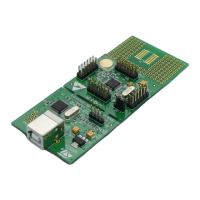RM0016 Power management
Doc ID 14587 Rev 8 101/449
10 Power management
By default, after a system or power reset, the microcontroller is in Run mode. In this mode
the CPU is clocked by f
CPU
and executes the program code, the system clocks are
distributed to the active peripherals and the microcontroller is drawing full power.
While in Run mode, still keeping the CPU running and executing code, the application has
several ways to reduce power consumption, such as:
● Slowing down the system clocks
● Gating the clocks to individual peripherals when they are unused
● Switching off any unused analog functions
However, when the CPU does not need to be kept running, three dedicated low power
modes can be used:
● Wait
● Active-halt (configurable for slow or fast wakeup)
● Halt (configurable for slow or fast wakeup)
You can select one of these three modes and configure them to obtain the best compromise
between lowest power consumption, fastest start-up time and available wakeup sources.
10.1 General considerations
Low power consumption features are generally very important for all types of application for
energy saving. Ultra low power features are especially important for mobile applications to
ensure long battery lifetimes. This is also crucial for environmental protection.
In a silicon chip there are two kind of consumption:
● Static power consumption which is due to analog polarization and leakages. This so
small, it is only significant in Halt and Active-halt modes (refer to Section 10.2: Low
power modes).
● Dynamic power consumption which comes from running the digital parts of the chip.
It depends on V
DD
, clock frequency and load capacitors.
In a microcontroller device the consumption depends on:
● V
DD
supply voltage
● Analog performance
● MCU size or number of digital gates (leakages and load capacitors)
● Clock frequency
● Number of active peripherals
● Available low power modes and low power levels
Device processing performance is also very important, as this allows the application to
minimize the time spent in Run mode and maximize the time in low power mode.
Using the MCU’s flexible power management features, you can obtain a range of significant
power savings while the system is running or able to resume operations quickly.

